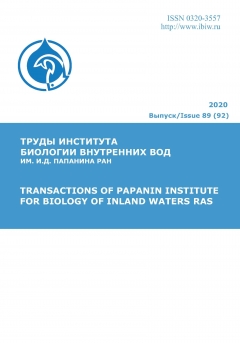UDC 574.64
The effect of short-term exposure to a low-frequency electromagnetic field (50 Hz, 10 μT) and thermal stress (water heating at a rate of 8 °C/h) on amylolytic (AA) and proteolytic (PA) activities, and maltase (AM) activity in the intestine, as well as acetylcholinesterase (AChE) activity and water-soluble protein (WSP) content in the brain of juvenile crucian carp Carassius gibelio fed a diet for 2 months with low (LMC; 0.07 mg/kg wet weight) and high (HMC; 0.182 mg/kg w.w) mercury were studied. The mercury content in the fish muscles of the HMC group (0.40 and 0.66 mg/kg) was approximately 2 times higher compared to the LMC group (0.22 and 0.30 mg/kg) after 1st and 2nd months of exposure, respectively. After 2 months of the experiment, AA increased by 30-48%, PA decreased by 30% only in the HMC group, while statistically significant differences were not revealed in the fish of the LMC and HMC groups. At this time AM levels were 77% (LMC) and 340% (HMC) higher compared to their values after 1st month, and simultaneously it was 36% higher in the HMC group than in the LMC group. No. changes in AChE activity were revealed either in different months or between the LMC and HMC groups. The WSP content was 40% lower in the fish of the LMC group in the 2nd month compared to the 1st month. Subsequent temperature stress (T) decreased AA and PA, electromagnetic field (EMF) and its combination with T, as a rule, increased the activity of these enzymes in fish of both groups. A decrease in the activity of AChE (EMF+T) and WSP (T) was found only in fish of the HMC group. In general, mercury entering with food increases the activity of the studied digestive enzymes, but does not affect the brain AChE activity and WSP content decreases only in the 1st month. Subsequent temperature stress and the action of EMF can change the magnitude and direction of the effect. The obtained results are important for assessing the environmental risks of chronic mercury exposure in areas of thermal and electromagnetic pollution of water bodies.
crucian carp, digestive enzymes, intestine, acetylcholinesterase, water-soluble protein, brain, mercury, bioaccumulation, electromagnetic field, temperature stress
1. Golovanov V.K. Temperaturnye kriterii zhiznedeyatel'nosti presnovodnyh ryb. M.: Poligraf-Plyus, 2013. 300 s.
2. Gorbatenko K.M., Lazhencev A.E. Biohimicheskiy sostav i kaloriynost' mintaya // Izv. TINRO. 2016. T. 184. S. 93–104.
3. Kuz'mina V.V. Processy pischevareniya u ryb. Novye fakty i gipotezy: monografiya / Institut biologii vnutrennih vod im. I.D. Papanina RAN. Yaroslavl': Filigran', 2018. 300 s.
4. Makeeva A.V., Klyuchko N.Yu. Issledovaniya po sovershenstvovaniyu receptury formovannyh morozhenyh polufabrikatov iz rechnogo okunya Perca fluviatilis povyshennoy biologicheskoy cennosti // Izvestiya KGTU. 2021. № 60. C. 97–110. DOI:https://doi.org/10.46845/1997-3071-2021-60-97-110.
5. Ugolev A.M., Iezuitova N.N., Masevich C.G., Nadirova T.Ya., Timofeeva N.M. Issledovanie pischevaritel'nogo apparata u cheloveka. Obzor sovremennyh metodov. L.: Nauka. 1969. 216 s.
6. Amlund H., Lundebye A.K., Berntssen M.H.G. Accumulation and elimination of methylmercury in Atlantic cod (Gadus morhua L.) following dietary exposure // Aquat. Toxicol. 2007. Vol. 83, № 4. P. 323–330. DOI:https://doi.org/10.1016/j.aquatox.2007.05.008.
7. Beitinger T.L., Bennett W.A., McCauley R.W. Temperature Tolerances of North American Freshwater Fishes Exposed to Dynamic Changes in Temperature // Environ. Biol. Fish. 2000. Vol. 58. P. 237–275. DOI:https://doi.org/10.1023/A:1007676325825.
8. Berntssen M.H.G., Hylland K., Julshamn K. Lundebye A.-K., Waagbo R. Maximum limits of organic and inorganic mercury in fish feed // Aquaculture Nutrition. 2004. Vol. 10. P. 83–97. DOI:https://doi.org/10.1046/j.1365-2095.2003.00282.x.
9. Bloom N.S. On the chemical form of mercury in edible fish and marine invertebrate tissues // Can. J. Fish. Aquat. Sci. 1992. Vol. 49. P. 1010–1017. DOI:https://doi.org/10.1139/f92-113.
10. Bradford M.M. A rapid and sensitive method for the quantitation of microgram quantities of protein utilizing the principal of protein-dye binding // Anal. Biochem. 1976. Vol. 72. P. 248–254. DOI:https://doi.org/10.1006/abio.1976.9999.
11. Chang, L. W. Neurotoxic effects of mercury (A review) // Environmental Research. 1977. Vol. 14(3). P. 329–373. DOI:https://doi.org/10.1016/0013-9351(77)90044-5.
12. Chuiko G.M., Podgornaya V.A., Zhelnin Y.Y. Acetylcholinesterase and butyrylcholinesterase activities in brain and plasma of freshwater teleosts: cross-species and cross-family differences // Comp. Biochem. Physiol. 2003. Vol. 135B, № 1. P. 55–61. DOI:https://doi.org/10.1016/s1096-4959(03)00048-4.
13. Ellman G.L., Courtney K.D., Andres V., Featherstone R.M. A new and rapid colorimetric determination of acetylcholi-nesterase activity // Biochem. Pharmacol. 1961. Vol. 70, № 2. P. 88–90. DOI:https://doi.org/10.1016/0006-2952(61)90145-9.
14. Farina M., Avila D.S., da Rocha J.B.T., Aschner M. Metals, oxidative stress and neurodegeneration: a focus on iron, manganese and mercury // Neurochem. Int. 2013. Vol. 62. P. 575–594. DOI:https://doi.org/10.1016/j.neuint.2012.12.006
15. Frasco M.F., Colletier J.-P., Weik M., Carvalho F., Guilhermino L., Stojan J., Fournier D. Mechanisms of cholinesterase inhibition by inorganic mercury // FEBS Journal. 2007. Vol. 274(7), 1849–1861. DOI:https://doi.org/10.1111/j.1742-4658.2007.05732.x.
16. Garina D.V. Influence of chronic intake of small doses of mercury on some biochemical parameters of lipid and protein metabolism in goldfish Carassius auratus (L., 1758) // Ecosystem Transformation. 2023. Vol. 6, № 3. P. 86–104. DOI:https://doi.org/10.23859/estr-220505.
17. Golovanova I.L., Filippov A.A., Chebotareva Yu.V., Krylov V.V. Long-Term Consequences of the Effect of Copper and an Electromagnetic Field on the Size and Weight Parameters and Activity of Digestive Glycosidases in Underyearlings of Roach Rutilus rutilus // Inland Water Biol. 2021. Vol. 14, № 3. P. 331–339. DOI:https://doi.org/10.1134/S1995082921020048.
18. Golovanova I.L., Golovanov V.K., Chuiko G.M., Podgornaia V.A., Aminov A.I. Effects of Roundup herbicide at low concentration and of thermal stress on physiological and biochemical parameters in Amur sleeper Perccottus glenii Dybowski juveniles // Inland Water Biol. 2019. № 4. P. 462–469. DOI:https://doi.org/10.1134/S1995082919040059.
19. Golovanova I.L., Komov V.T. Impact of Mercury on Hydrolysis of Carbohydrates in the Intestine of the River Perch Perca fluviatilis // J. Ichthyology. 2005. Vol. 45. № 8. P. 663–668.
20. Golovanova I.L., Komov V.T., Gremyatchikh V.A. Hydrolysis of Carbohydrates in Roach (Rutilus rutilus L.) at Different Levels of Mercury Accumulation // Inland Water Biol. 2008. Vol. 1. № 3. P. 296–302. DOI:https://doi.org/10.1134/S1995082908030140.
21. Grippo M.A., Heath A.G. The effect of mercury on the feeding behavior of fathead minnows (Pimephales promelas) // Ecotoxicol. Environ. Saf. 2003. Vol. 55. P. 187–198. DOI:https://doi.org/10.1016/S0147-6513(02)00071-4.
22. Haines T.A., Komov V.T., Matey V.E., Jagoe C.H. Perch mercury content is related to acidity and color of 26 Russian lakes // Water Air Soil Pollut. 1995. Vol. 85. P. 823–828. DOI:https://doi.org/10.1007/BF00476931.
23. Hall B.D., Bodaly R.A., Furge R.J.P., Rudd J.W.M., Rosenberg D.M. Food as the dominant pathway of methylmercury uptake by fish // Water Air Soil Pollut. 1997. Vol. 100. P. 13–24. DOI:https://doi.org/10.1023/A:1018071406537.
24. Kuz’mina V.V., Komov V.T., Gremyachikh V.A., Rusanova P.V. Activity of Digestive Hydrolases in Carp Cyprinus carpio with Different Mercury Content in Food // J. Ichthyol. 2013. Vol. 53, №. 4. P. 301–309. DOI:https://doi.org/10.7868/S0042875213020082.
25. Kuz’mina V.V., Skvortsova E.G., Pivovarova E.A., Bushkareva A.S., Vostrova U.A., Poltoratskaya A.V. Influence of sapropel on the activity of intestinal peptidases of broiler chickens // J. Indonesian Trop. Anim. Agric. 2021. Vol. 46, № 1. P. 67–74. DOI:https://doi.org/10.14710/jitaa.46.1.67-74.
26. Kuz’mina V.V., Ushakova N.V., Krylov V.V. The Effect of Magnetic Fields on the Activity of Proteinases and Glycosidases in the Intestine of the Crucian Carp Carassius carassius // Biology Bulletin. 2015. Vol. 42, № 1. P. 61–66. DOI:https://doi.org/10.1134/S1062359015010070.
27. Li Z.-H., Li P., Wu Y. Effects of waterborne mercury at different temperatures on hematology and energy metabolism in grass carp (Ctenopharyngodon idella) // Int. J. of Environ. Sci. and Tech. 2021. Vol. 18, № 6. P. 1489–1498. DOI:https://doi.org/10.1007/s13762-020-02906-7.
28. Melakea B.A., Endalewa S.M., Alamerewa T.S. Bioaccumulation of Perfluoroalkyl Substances and Mercury in Fish Tissue: A Global Systematic Review // J. Polymer Sci. 2023. Vol. 8, № 2. P. 21–25. DOI:https://doi.org/10.36648/2471-9935.23.8.011.
29. Nunes B. The Use of Cholinesterases in Ecotoxicology // Reviews of Environmental Contamination and Toxicology. 2011. Vol. 212. P. 29–59. DOI:https://doi.org/10.1007/978-1-4419-8453-1_2.
30. Pereira P., Puga S., Cardoso V., Pinto-Ribeiro F., Raimundo J., Barata M., Pousgo-Ferreira P., Pacheco M., Almeida A. Inorganic mercury accumulation in brain following waterborne exposure elicits a deficit on the number of brain cells and impairs swimming behavior in fish (white seabream-Diplodus sargus) // Aquat. Toxicol. 2016. Vol. 170. P. 400–412. DOI:https://doi.org/10.1016/j.aquatox.2015.11.031.
31. Rodgers D.W., Beamish F.W.H. Dynamics of dietary methylmercury in rainbow trout, Salmo gairdneri // Aquat. Toxicol. 1982. Vol. 2. P. 271–290.
32. Schartup A.T., Thackray C.P., Qureshi A., Dassuncao C., Gillespie K., Hanke A., Sunderland E. M. Climate change and overfishing increase neurotoxicant in marine predators // Nature. 2019. Vol. 572. P. 648–650. DOI:https://doi.org/10.1038/s41586-019-1468-9.
33. Sokolova I.M., Lannig G. Interactive effects of metal pollution and temperature on metabolism in aquatic ectotherms: implications of global climate change // Clim. Res. 2008. Vol. 37. P. 181–201. DOI:https://doi.org/10.3354/cr00764.
34. Webber H.M., Haines T.A. Mercury effects on predator avoidance behavior of a forage fish, golden shiner (Notemigonus crysoleucas) // Environ. Toxicol. Chem. 2003. Vol. 22, № 7. P. 1556–1561. DOI:https://doi.org/10.1002/etc.5620220718.
35. Zhou T., Scali R., Weis P., Weis J.S. Behavioral effects in mummichog larvae (Fundulus heteroclitus) following embryonic exposure to methylmercury // Mar. Environ. Res. 1996. Vol. 42. P. 45–49.








